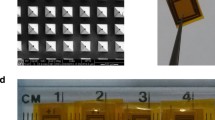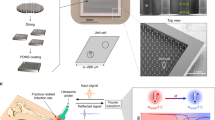Abstract
Recent advances in multimodal sensing technology and sensor miniaturization technologies are paving the way for a new era in physiological measurement. Traditional approaches have integrated several transducers on a single silicon chip or packaged several sensing elements within a biocompatible catheter. Thermal and electrical cross-talk between sensors, time-lag between parallel measurements, lower yields associated with the increased complexity, and restrictions on the minimum size are challenges presented by these approaches. We present an alternative method which enables simultaneous measurement of temperature, pressure and heart rate to be obtained from a single ultra-miniature solid-state transducer. For the first time multimodal data were obtained from the sensor located within the abdominal aortas of five rats. The catheter-tip sensor interfaces with a fully implanted and inductively powered telemetry device capable of operating for the lifetime of the animal. Results of this study demonstrate good agreement between the core-temperature measurement from the catheter-tip sensor and the reference sensor with mean difference between the two sensors of 0.03 °C ± 0.02 °C (n = 5, 7 days). Real-time data obtained in the undisturbed rat, revealed fluctuations associated with the rest-activity cycle, in temperature, mean arterial pressure and heart rate. The stress response was shown to elicit an elevation in the core temperature of 1.5 °C. This was heralded by an elevation in mean arterial pressure of 35 mmHg and heart rate of 160 bpm. Obtaining multiple parameters from a single transducer goes a considerable way towards overcoming challenges of the prior art.








Similar content being viewed by others
References
G. Berggren, E.H. Christensen, Heart rate and body temperature as indices of metabolic rate during work. Arbeitsphysiologie 14(3), 255–260 (1950)
S.L. Bratton, R.M. Chestnut, J. Ghajar, F.F. McConnell Hammond, O.A. Harris, R. Hartl et al., Guidelines for the management of severe traumatic brain injury. VI. Indications for intracranial pressure monitoring. J. Neurotrauma 24(Suppl 1), S37–S44 (2007)
D.M. Budgett, A.P. Hu, P. Si, W.T. Pallas, M.G. Donnelly, J.W. Broad et al., Novel technology for the provision of power to implantable physiological devices. J. Appl. Physiol. 102(4), 1658–1663 (2007)
C. Childs, T. Wieloch, F. Lecky, G. Machin, B. Harris, N. Stocchetti, Report of a consensus meeting on human brain temperature after severe traumatic brain injury: its measurement and management during pyrexia. Front. Neurol. 1 (2010)
T.M. Clark, S.C. Malpas, D. McCormick, P. Heppner, D.M. Budgett, A new tool for the neurointensive care unit: simultaneous measurement of temperature from a catheter-tip pressure sensor. IEEE Sensors J 15(3), 1761–1769 (2015)
D. Closa, M. Alemany, X. Remesar, Effect of cold-exposure on organ temperatures in wistar and zucker fa/fa rat. J. Therm. Biol. 17(2), 83–88 (1992a)
D. Closa, M. Alemany, X. Remesar, Effect of food-deprivation and refeeding on rat organ temperatures. Arch. Int. Physiol. Biochim. Biophys. 100(3), 207–211 (1992b)
D. Closa, J. Gomez-Sierra, E. Latres, M. Alemany, X. Remesar, Short-term oscillations of aortic core temperature and thermogenic organ blood flow in the rat. Exp. Physiol. 78(2), 243–253 (1993)
J. De Vries, J. Strubbe, W. Wildering, J. Gorter, A. Prins, Patterns of body temperature during feeding in rats under varying ambient temperatures. Physiol. Behav. 53(2), 229–235 (1993)
M.D. Delp, M.V. Evans, C. Duan, Effects of aging on cardiac output, regional blood flow, and body composition in fischer-344 rats. J. Appl. Physiol. 85(5), 1813–1822 (1998)
H. Dudaicevs, M. Kandler, Y. Manoli, W. Mokwa, E. Spiegel, Surface micromachined pressure sensors with integrated CMOS read-out electronics. Sensors Actuators A Phys. 43(1–3), 157–163 (1994)
R. Eikelboom, Learned anticipatory rise in body temperature due to handling. Physiol. Behav. 37(4), 649–653 (1986)
E. Gabmann, A. Gries, Electronic Pressure Measurement (Verlag Moderne Industrie, 2010)
J. Goosen, P. French, P. Sarro, Pressure, flow and oxygen saturation sensors on one chip for use in catheters. Paper presented at the Micro Electro Mechanical Systems, 2000. The Thirteenth Annual International Conference. (2000).
C.J. Gordon, Quantifying the instability of core temperature in rodents. J. Therm. Biol. 34(5), 213–219 (2009)
R.J. Irvine, J. White, R. Chan, The influence of restraint on blood pressure in the rat. J. Pharmacol. Toxicol. Methods 38(3), 157–162 (1997)
Y. Kanda, A graphical representation of the piezoresistance coefficients in silicon. IEEE Trans. Electron Devices 29(1), 64–70 (1982)
Y. Kanda, Piezoresistance effect of silicon. Sensors Actuators A Phys. 28(2), 83–91 (1991)
K. Kramer, L.B. Kinter, Evaluation and applications of radiotelemetry in small laboratory animals. Physiol. Genomics 13(3), 197–205 (2003)
V. Lemaire, P. Mormède, Telemetered recording of blood pressure and heart rate in different strains of rats during chronic social stress. Physiol. Behav. 58(6), 1181–1188 (1995)
C. Li, P.M. Wu, J. Han, C.H. Ahn, A flexible polymer tube lab-chip integrated with microsensors for smart microcatheter. Biomed. Microdevices 10(5), 671–679 (2008)
C. Li, P.M. Wu, Z. Wu, C.H. Ahn, D. Ledoux, L.A. Shutter et al., Brain temperature measurement: a study of in vitro accuracy and stability of smart catheter temperature sensors. Biomed. Microdevices 14(1), 109–118 (2012)
Millar Inc, Telemetry user manual for small animal systems (Millar Inc, Auckland, 2014)
R. Schlierf, U. Horst, M. Ruhl, T. Schmitz-Rode, W. Mokwa, U. Schnakenberg, A fast telemetric pressure and temperature sensor system for medical applications. J. Micromech. Microeng. 17(7), S98 (2007)
E. Stehlin, S.C. Malpas, D.M. Budgett, C.J. Barrett, D. McCormick, G. Whalley et al., Chronic measurement of left ventricular pressure in freely moving rats. J. Appl. Physiol. 115(11), 1672–1682 (2013)
K.M. Studholme, H.S. Gompf, L.P. Morin. Brief light stimulation during the mouse nocturnal activity phase simultaneously induces a decline in core temperature and locomotor activity followed by EEG-determined sleep. Am J Physiol Regul Integr Comp Physiol 304(6), R459–R471 (2013)
D. Tanase, J.F. Goosen, P.J. Trimp, P.J. French, Multi-parameter sensor system with intravascular navigation for catheter/guide wire application. Sensors Actuators A Phys. 97, 116–124 (2002)
A. Werner, H.-C. Gunga, Monitoring of Body Core Temperature in Humans, Stress Challenges and Immunity in Space (Springer, 2012), pp. 309–326
Y.L. Yang, N. Wang, H.X. Song, Z.L. Shen, B. Sun, Y. Tang, Simultaneous telemetric monitoring of the circadian changes in core and BAT temperature in rats: Endogenous vasopressin may contribute to reduced BAT themogenesis and body temperature in the light phase of the circadian cycle. J. Therm. Biol. 37(4), 316–322 (2012)
T.J.J. Zethof, J.A.M. Van Der Heyden, J.T.B.M. Tolboom, B. Olivier, Stress-induced hyperthermia in mice: a methodological study. Physiol. Behav. 55(1), 109–115 (1994)
Acknowledgments
The authors are grateful to Stephanie Lindsay for her technical assistance.
Compliance with ethical standards
ᅟ
Funding
This work was supported by the Health Research Council of New Zealand. Sensors were provided by Millar Inc.
Conflict of interest
Simon C. Malpas, Daniel McCormick, Sarah-Jane Guild and David M. Budgett are employees of Millar Ltd.
Ethical approval
All procedures performed in studies involving animals were in accordance with the ethical standards of the University of Auckland at which the studies were conducted. All applicable international, national, and institutional guidelines for the care and use of animals were followed.
Author information
Authors and Affiliations
Corresponding author
Rights and permissions
About this article
Cite this article
Clark, T.M., Malpas, S.C., McCormick, D. et al. New multimodal data obtained in-vivo from a single ultra-miniature transducer. Biomed Microdevices 17, 72 (2015). https://doi.org/10.1007/s10544-015-9984-3
Published:
DOI: https://doi.org/10.1007/s10544-015-9984-3




